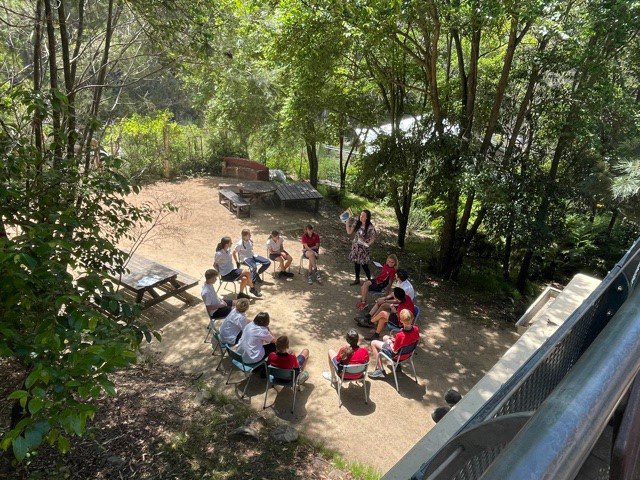
There’s an old architectural design mantra that promotes Bringing the Outside In, which is about using large natural forms and building them into internal design principles. Over the past few weeks we’ve been doing exactly the opposite, and Taking the Inside Out. The need for good ventilation has driven many classes outside, and what a breath of fresh air it has brought, in all meanings of the term.
At Middle Cove we are using seven “official” new outside learning spaces to ensure all our high school lessons are as ventilated as possible. There are other less official spaces that teachers have found, in outdoor nooks and crannies that can accommodate smaller groups of students. Our bushland campus has really come into its own as all schools struggle to ensure students and teachers are as ventilated as possible.
Now there are challenges in outdoor learning. As any good teacher knows, a lesson needs to have a sense of integrity, a “skin” around it that holds the students and teacher/s in a unity with a common purpose in learning. In simple terms, everyone, both students and teacher, need to focus on the lesson and on their common task, otherwise the learning is less.
The four walls of the usual classroom space provide a physical boundary that gives one layer of the “skin” around a lesson. But as we all know, that’s not enough, and a lesson can so easily lose focus even within the most solid walls.
It’s the art of the teacher to create the intangible “skin” by drawing the students into the web of interest, enthusiasm and focused attention that every good lesson needs. Teachers create the “skin” themselves and learning this art, for an art it is, is the result of the sheer hard work that goes into training to be a teacher.
So taking lessons outside has a big challenge in one sense. How do you sustain student attention when you have kookaburras cackling, the wind on the trees, a distant chainsaw and the odd brush turkey wandering past, not to mention the visual distractions of a panorama of pleasant trees to look at? So the art of the teacher comes into its own in the outdoor classroom setting. Teachers need to be on their toes keeping attention and focus.
But the benefits are immense. At a time when clean air is a precious commodity, the sheer quality of fresh air at Middle Cove is impressive. The thick natural forest next to the waters of Middle Harbour create a highly oxygenated air flow which must make the campus one of the healthiest educational settings you can imagine.
Outdoor learning is nothing new to Glenaeon, it’s been part of our DNA since inception. Embedding learning in a natural environment was the foundational design of the school. One of the founders of our school Eric Nicholls, the junior partner of Walter and Marion Burly Griffin, first articulated his plans for a school in a natural setting as early as 1952, when he described his vision of creating a village-like series of classroom buildings in a bushland setting. His foundational design has echoed on in all the design principles that have shaped Glenaeon’s grounds ever since. Every window in the school looks out on to trees and green spaces.
How ahead of his time was that? Research that started at the University of Colorado in the 1990’s found some interesting results regarding health and wellbeing connected with “green” school yards. In general, and screening out such factors as socio-economic advantage, they found a connection between green spaces on a school campus and the health and wellbeing of its student population. The research is population research, so it covers many schools and many students, but it does suggest we have about as healthy a schoolyard as you can get. The Japanese “Forest Bathing’ movement with its associated research is demonstrating the physical benefits of extended time in forest settings, which is what our students enjoy every day.
The research is so pertinent in this time when air quality for students is such a hot topic. A local researcher is now working on the health of Australian high school grounds: Gweneth Leigh at the University of Canberra is completing a PhD on the how the design of secondary schoolyards has an impact on the wellbeing of students. She is hoping to raise awareness of how profoundly important green school grounds are for student wellbeing and health. Glenaeon is part of her study and we have shared our vision and practice of learning that is integrated into the natural environment.
Hopefully one silver lining from this challenging time might be a realisation that we need to take the inside out more often in schools. Students need their learning integrated into natural spaces for health and wellbeing reasons. If as a society we can learn that, it really will be a breath of fresh air.
Andrew Hill
Head of School




